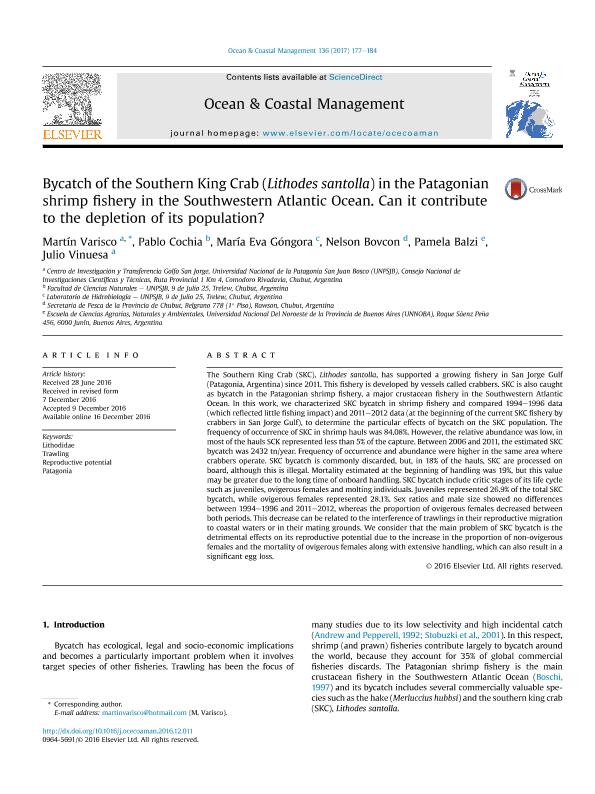Mostrar el registro sencillo del ítem
dc.contributor.author
Varisco, Martin Alejandro

dc.contributor.author
Cochia, Pablo
dc.contributor.author
Góngora, María Eva

dc.contributor.author
Bovcon, Nelson Darío

dc.contributor.author
Balzi, Pamela
dc.contributor.author
Vinuesa, Julio Hector

dc.date.available
2019-03-30T00:14:33Z
dc.date.issued
2017-02
dc.identifier.citation
Varisco, Martin Alejandro; Cochia, Pablo; Góngora, María Eva; Bovcon, Nelson Darío; Balzi, Pamela; et al.; Bycatch of the Southern King Crab (Lithodes santolla) in the Patagonian shrimp fishery in the Southwestern Atlantic Ocean. Can it contribute to the depletion of its population?; Elsevier; Ocean & Coastal Management; 136; 2-2017; 177-184
dc.identifier.issn
0964-5691
dc.identifier.uri
http://hdl.handle.net/11336/72891
dc.description.abstract
The Southern King Crab (SKC), Lithodes santolla, has supported a growing fishery in San Jorge Gulf (Patagonia, Argentina) since 2011. This fishery is developed by vessels called crabbers. SKC is also caught as bycatch in the Patagonian shrimp fishery, a major crustacean fishery in the Southwestern Atlantic Ocean. In this work, we characterized SKC bycatch in shrimp fishery and compared 1994–1996 data (which reflected little fishing impact) and 2011–2012 data (at the beginning of the current SKC fishery by crabbers in San Jorge Gulf), to determine the particular effects of bycatch on the SKC population. The frequency of occurrence of SKC in shrimp hauls was 84.08%. However, the relative abundance was low, in most of the hauls SCK represented less than 5% of the capture. Between 2006 and 2011, the estimated SKC bycatch was 2432 tn/year. Frequency of occurrence and abundance were higher in the same area where crabbers operate. SKC bycatch is commonly discarded, but, in 18% of the hauls, SKC are processed on board, although this is illegal. Mortality estimated at the beginning of handling was 19%, but this value may be greater due to the long time of onboard handling. SKC bycatch include critic stages of its life cycle such as juveniles, ovigerous females and molting individuals. Juveniles represented 26.9% of the total SKC bycatch, while ovigerous females represented 28.1%. Sex ratios and male size showed no differences between 1994–1996 and 2011–2012, whereas the proportion of ovigerous females decreased between both periods. This decrease can be related to the interference of trawlings in their reproductive migration to coastal waters or in their mating grounds. We consider that the main problem of SKC bycatch is the detrimental effects on its reproductive potential due to the increase in the proportion of non-ovigerous females and the mortality of ovigerous females along with extensive handling, which can also result in a significant egg loss.
dc.format
application/pdf
dc.language.iso
eng
dc.publisher
Elsevier

dc.rights
info:eu-repo/semantics/openAccess
dc.rights.uri
https://creativecommons.org/licenses/by-nc-sa/2.5/ar/
dc.subject
Lithodidae
dc.subject
Patagonia
dc.subject
Reproductive Potential
dc.subject
Trawling
dc.subject.classification
Otras Ciencias Biológicas

dc.subject.classification
Ciencias Biológicas

dc.subject.classification
CIENCIAS NATURALES Y EXACTAS

dc.title
Bycatch of the Southern King Crab (Lithodes santolla) in the Patagonian shrimp fishery in the Southwestern Atlantic Ocean. Can it contribute to the depletion of its population?
dc.type
info:eu-repo/semantics/article
dc.type
info:ar-repo/semantics/artículo
dc.type
info:eu-repo/semantics/publishedVersion
dc.date.updated
2019-03-29T12:07:32Z
dc.journal.volume
136
dc.journal.pagination
177-184
dc.journal.pais
Países Bajos

dc.journal.ciudad
Amsterdam
dc.description.fil
Fil: Varisco, Martin Alejandro. Consejo Nacional de Investigaciones Científicas y Técnicas; Argentina. Universidad Nacional de la Patagonia Austral. Centro de Investigaciones y Transferencia Golfo San Jorge. Consejo Nacional de Investigaciones Científicas y Técnicas. Centro de Investigaciones y Transferencia Golfo San Jorge. Universidad Nacional de la Patagonia "San Juan Bosco". Centro de Investigaciones y Transferencia Golfo San Jorge; Argentina. Universidad Nacional de la Patagonia "San Juan Bosco". Facultad de Ciencias Naturales - Sede Comodoro. Departamento de Bioquímica; Argentina
dc.description.fil
Fil: Cochia, Pablo. Universidad Nacional de la Patagonia "San Juan Bosco". Facultad de Ciencias Naturales - Sede Trelew; Argentina
dc.description.fil
Fil: Góngora, María Eva. Universidad Nacional de la Patagonia "San Juan Bosco". Facultad de Ciencias Naturales - Sede Trelew. Departamento de Biología. Laboratorio de Hidrobiología; Argentina
dc.description.fil
Fil: Bovcon, Nelson Darío. Consejo Nacional de Investigaciones Científicas y Técnicas; Argentina. Provincia de Chubut. Secretaria de Pesca; Argentina
dc.description.fil
Fil: Balzi, Pamela. Universidad Nacional del Noroeste de la Provincia de Buenos Aires; Argentina
dc.description.fil
Fil: Vinuesa, Julio Hector. Consejo Nacional de Investigaciones Científicas y Técnicas; Argentina. Universidad Nacional de la Patagonia Austral. Centro de Investigaciones y Transferencia Golfo San Jorge. Consejo Nacional de Investigaciones Científicas y Técnicas. Centro de Investigaciones y Transferencia Golfo San Jorge. Universidad Nacional de la Patagonia "San Juan Bosco". Centro de Investigaciones y Transferencia Golfo San Jorge; Argentina. Universidad Nacional de la Patagonia "San Juan Bosco". Facultad de Ciencias Naturales - Sede Comodoro. Departamento de Bioquímica; Argentina
dc.journal.title
Ocean & Coastal Management

dc.relation.alternativeid
info:eu-repo/semantics/altIdentifier/doi/https://doi.org/10.1016/j.ocecoaman.2016.12.011
dc.relation.alternativeid
info:eu-repo/semantics/altIdentifier/url/https://www.sciencedirect.com/science/article/pii/S0964569116304112
Archivos asociados
